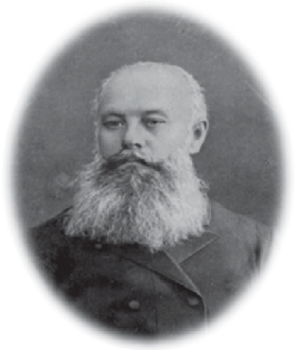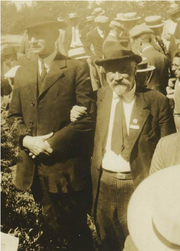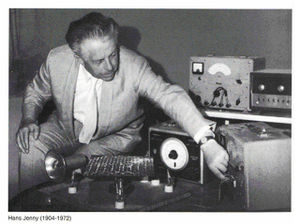Founders of Soil Concepts
The founders of soil concepts are the primary scientists that saw soil as fundamental to human life and realized soil's intrinsic value and its importance to planet Earth. They initiated the study of soil, and created a foundation for soil science to be researched and expanded in future generations. These select founders include the likes of Vasily Dokuchaev, Konstantin Glinka, Curtis F. Marbut, and Hans Jenny.
Vasily Dokuchaev

The first scientific view of soils as natural bodies that develop under the influence of climate and biological activity acting on geological substrates arose in Russia with the work of Vasily Dokuchaev [3]. Born in Russia in 1846, being the son of a priest, Dokuchaev gained interest in natural science and eventually obtained his doctorate in geology, becoming curator of the geological laboratory at St. Petersburg University in 1872 [2]. He is commonly recognized as the founder of pedology, due to making the case for studying soil science as a subject in its own right saying, "time is not far when in its own right and because of its great importance for humanity, it will occupy an independent and fully respected place” [2]. There were some who Dokuchaev derived ideas from, but he was the one to transform many of the existing views and hypothesis into a logical theory that was useful for predicting soil distributions and formation [4]. He perceived soil to be an “independent natural body”, and suggested independently that soil development was principally controlled by climate and vegetation [1]. His theory and model, along with its subtle permutations, have been examined and praised in countless textbooks, conferences, symposia, and professional papers, and institutes, awards, medals, celebrations, museums, and even a crater on Mars, have been named in his honor [4]. The longevity of Vasily Dokuchaev’s work has then been prolonged by his students, colleagues, and Russian peers.
Konstantin Glinka and Curtis F. Marbut

Russian scientist Konstantin Glinka was one of Dokuchaev’s students that continued his work and expanded on his soil concepts. Born in 1867, Glinka was Director of Agricultural College of Leningrad and Experimental Station, and the first director of the Dokuchaev Soil Science Institute. His take was that soil is, “… not only a natural body with definite properties, but also its geographical position and surroundings, i.e., climate, vegetation, and animal life” [3]. He wrote, and expanded on his thinking in his book, "Die Typen der Bodenbil" (The Types of Soil), which helped bring foreign soil ideology and science to the United States.
Glinka’s work was translated to English in 1917 by an American soil scientist, Curtis F. Marbut, the then director of the Division of Soil Survey at US Department of Agriculture (USDA) [2]. Marbut, born in 1863, started out as an instructor of geology and mineralogy at the University of Missouri, until he positioned himself as a soil scientist at the USDA post 1909 [5]. There he looked into the work of foreign soil scientists, and took inspiration from Glinka in pursuing new methods of conducting field work [5]. Marbut realized that the Russian perspective predates the formal statement of the ecosystem concept by several decades and decided to translate the Russian scientist's work into English [3]. His introduction to Russian pedological theory inspired him to transform many aspects of the US soil classification system, and the way in which soils were studied in the United States [2].
Hans Jenny

Scientist Hans Jenny was one of those that took advantage of the introduction of Russian soil concepts in the US. He made a breakthrough in his reformulation and further quantification of Dokuchaev’s soil interpretation. In his published literature, “Factors of Soil Formation: A System of Quantitative Pedology” (1941), he provided a detailed definition of both soil and the "larger system," as well as a method to quantitatively and numerically link soil and larger system properties to state factors [2]. In that book, Jenny coined the term “pedogenesis”, which is the process of soil formation, and formulated this concept into the now famous “fundamental equation of soil-forming factors” or Jenny Equation: s = f (cl, o, r, p, t, …) [3]. This equation states that the state of a body of soil at a point in time (s), refers to the function (f) of five interrelated factors: climate (cl), organisms (o), relief or topography (r), parent material (p), and time (t) [1]. He also inserted an ellipsis (…) in the equation for other possible factor that he did not consider at the time. Jenny, probably more than any North American soil scientist of his era, emphasized the importance of the biota in and upon soils [3]. Since his work, research in soil science has experienced a “renaissance” as the significance of biological activity in soil formation, organic matter dynamics, and nutrient cycling have become widely recognized [3].
References
[1] “CHAPTER 10: Introduction to the Lithosphere (u). Soil Pedogenesis.” Physical Geography, www.physicalgeography.net/fundamentals/10u.html.
[2] Amundson, Ronald, and Hans Jenny. “On a State Factor Model of Ecosystems.” BioScience, 1 Sept. 1997, www.jstor.org/stable/1313122?origin=JSTOR-pdf&seq=1#page_scan_tab_contents.
[3] Historical Overview of Soils and the Fitnes of the Soil Environment.” Fundamentals of Soil Ecology, by David C Coleman, 2nd ed., 2004.
[4] Johnson, Donald L, and Randall J Schaetzl. “Differing Views of Soil and Pedogenesis by Two Masters: Darwin and Dokuchaev.” pp. 1–14., www.geo.msu.edu/extra/schaetzl/PDFs/Johnson-Schaetzl2014.pdf..
[5] “Curtis F. Marbut (1863 - 1935).” Curtis F. Marbut - Historic Missourians - The State Historical Society of Missouri, www.shsmo.org/historicmissourians/name/m/marbut/.
[6] SINGH, S.K., and P. CHANDRAN. SOIL SCIENCE-AN INTRODUCTION Edition: FirstChapter: 3. Indian Society of Soil Science, www.researchgate.net/publication/314453325_SOIL_GENESIS_AND_CLASSIFICATION_Upon_this_handful_of_soil_our_survival_depends_Husband_it_and_it_will_grow_our_food_our_fuel_and_our_shelter_and_surround_us_with_beauty_Abuse_it_and_the_soil_will_coll/figures?lo=1.
[7] Brevik, Eric & Hartemink, Alfred. (2010). History, Philosophy, and Sociology of Soil Science. www.eolss.net.
[8] Faisca, F. “Hans Jenny and Cymatics - The Study of Wave Phenomena.” Hans Jenny and Cymatics, www.unitedearth.com.au/sound.html.